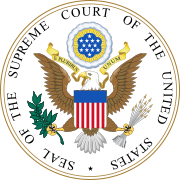|
List of United States Supreme Court cases, volume 12
This is a list of cases reported in volume 12 (8 Cranch) of United States Reports, decided by the Supreme Court of the United States in 1814.[1] Nominative reportsIn 1874, the U.S. government created the United States Reports, and retroactively numbered older privately-published case reports as part of the new series. As a result, cases appearing in volumes 1–90 of U.S. Reports have dual citation forms; one for the volume number of U.S. Reports, and one for the volume number of the reports named for the relevant reporter of decisions (these are called "nominative reports"). William CranchStarting with the 5th volume of U.S. Reports, the Reporter of Decisions of the Supreme Court of the United States was William Cranch. Cranch was Reporter of Decisions from 1801 to 1815, covering volumes 5 through 13 of United States Reports which correspond to volumes 1 through 9 of his Cranch's Reports. As such, the dual form of citation to, for example, Hall v. Leigh is 12 U.S. (8 Cranch) 50 (1814). Justices of the Supreme Court at the time of 12 U.S. (8 Cranch)The Supreme Court is established by Article III, Section 1 of the Constitution of the United States, which says: "The judicial Power of the United States, shall be vested in one supreme Court . . .". The size of the Court is not specified; the Constitution leaves it to Congress to set the number of justices. Under the Judiciary Act of 1789 Congress originally fixed the number of justices at six (one chief justice and five associate justices).[2] Since 1789 Congress has varied the size of the Court from six to seven, nine, ten, and back to nine justices (always including one chief justice). When the cases in 12 U.S. (8 Cranch) were decided, the Court comprised these seven justices:
Notable case in 12 U.S. (8 Cranch)United States v. 1960 Bags of CoffeeUnited States v. 1960 Bags of Coffee, 12 U.S. (8 Cranch) 398 (1814), is an example of a case in rem. In rem jurisdiction ("power about or against the thing")[3] is a legal term describing the power a court may exercise over property (either real or personal) or a "status" against a person over whom the court does not have in personam jurisdiction. Jurisdiction in rem assumes the property or status is the primary object of the action, rather than personal liabilities not necessarily associated with the property. In this case the coffee had been seized for being imported in violation of the Non-Intercourse Act of 1809. Citation styleUnder the Judiciary Act of 1789 the federal court structure at the time comprised District Courts, which had general trial jurisdiction; Circuit Courts, which had mixed trial and appellate (from the US District Courts) jurisdiction; and the United States Supreme Court, which had appellate jurisdiction over the federal District and Circuit courts—and for certain issues over state courts. The Supreme Court also had limited original jurisdiction (i.e., in which cases could be filed directly with the Supreme Court without first having been heard by a lower federal or state court). There were one or more federal District Courts and/or Circuit Courts in each state, territory, or other geographical region. Bluebook citation style is used for case names, citations, and jurisdictions.
List of cases in 12 U.S. (8 Cranch)
Notes and references
See alsoExternal links
Wikisource has original text related to this article:
|
||||||||||||||||||||||||||||||||||||||||||||||||||||||||||||||||||||||||||||||||||||||||||||||||||||||||||||||||||||||||||||||||||||||||||||||||||||||||||||||||||||||||||||||||||||||||||||||||||||||||||||||||||||||||||||||||||||||||||||||||||||||||||||||||||||||||||||||||||||||||||||||||||||||||||||||||||||||||||||||||||||||||||||||||||||||||||||||||||||||||||||||||||||||||||||||||||||||||||||||||||||||||||||||||||||||||||||||||||||











